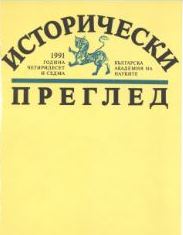Господстващата класа в средновековна България XIII–XIV в. по терминологията на среднобългарските паметници
The Ruling Class in Mediaeval Bulgaria in the 13th –14th centuries according to the Terminology of the Bulgarian Sources from the Middle Ages
Author(s): Kiril PetkovSubject(s): History, Social history, Middle Ages, 13th to 14th Centuries
Published by: Институт за исторически изследвания - Българска академия на науките
Summary/Abstract: The study is an attempt to clarify the notion of the mediaeval authors from the 13th – 14th centuries about the social structure of the ruling class according to the terminology of the different sources from the Middle Ages – saints’ lives, panegyrics, marginal notes, translated and domestic chronicles. According to the data at our disposal, we can say, there are various social terms for those who have the power in mediaeval Bulgaria: “boljarin”, “vlastel”, “velmozha”, “knjaz”. In our opinion, their presence in the sources is a landmark in the development of the concept of lordship in the High Bulgarian Middle Ages. The most used term is “boljarin”. From the restoration of the Second Bulgarian Kingdom, it is a general term for the representatives of the ruling class. Yet, from the middle of the 13th century another meaning begins to dominate in the connotation of the term — the sense of the owner, especially the landowner. In addition, the sources show that the expression “great-small” boljars is not an estate division, but a simpler one, making no difference whoever it is. But the division in the ruling class existed, and another group were the “vlastels”. In the 13th – 14th centuries with “vlastel” were indicated state and king ministers, no matter what their rank in the society was. The main distinction between the “vlastels” and the “boljars” was the origin of their power. The “vlastels” possessed part of the public authority, the others owed their position in society to the land ownership. In the beginning of the 14th century mainly from the “vlastels” derive two terminologically distinguished groups – the “velmozha’s” and the “knjaz’s”. The new terms show a process of stratification, that the traditional term “boljarin” cannot mark.
Journal: Исторически преглед
- Issue Year: 1991
- Issue No: 9
- Page Range: 3-16
- Page Count: 14
- Language: Bulgarian
- Content File-PDF

